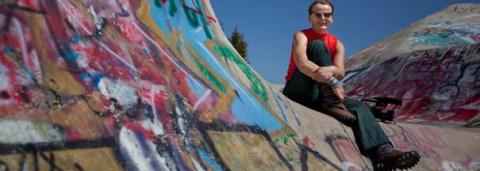Graffiti Research: Pop culture integration in art education

Beneath the boldly colourful, intricate designs that appear overnight on trains, buildings, underpasses and other surfaces hums a vibrant community of artists who embrace high standards of moral, social and artistic integrity.
This microcosm of a learning community, she learned, also includes break-dancing, DJing and skateboarding as art forms. It is propelled by youth, flourishes without ethnic, religious or social bias and, while operating largely subversively, gives rise to talented, intelligent, goal-oriented individuals.
Rahn, who is an artist and professor at the Faculty of Education, researched the evolution of individuals within the Montreal hip hop graffiti community, from an educational perspective, producing four videos, a book, Painting Without Permission: Hip-hop Graffiti Subculture (Bergin & Garvey 2002), exhibitions, and catalogues.
She was struck by the culture’s hallmark attitudes of respect and generosity. “There’s a huge mentoring system,” she relates. Established artists share technical knowledge and history of the form with emerging artists who “have a responsibility to acknowledge their mentors and then give back by influencing others.” Those who work “without skills and don’t follow the ethics of the community” are ostracized.
Serious graffiti practitioners view themselves as beautifying the environment while making social and political statements. Their pieces are temporary – eventually painted over – they work largely covertly and they receive no income and little recognition. Yet they continue, motivated purely by love for art, and the respect of their peers.
Rahn noted the contrast between this do-it-yourself street ethic and modern classrooms, in which students are often focused on the incentives of grades and degrees rather then authentic learning. She sought ways to inspire in academic settings the drive for knowledge and the pleasure of learning within a supportive community that she encountered in alleyways and abandoned warehouses.
Rahn now uses this experience to inform her teaching and research. After showing students in the Faculty of Education her video of hip-hop graffiti artists at work, she says to them, “This is the kind of passion and motivation for learning, that I want to see from you within this classroom and the broader community.” She encourages them to pay attention to what motivates popular youth culture and how this can inform traditional teaching without becoming normalized. She stresses the importance of peer influence, audience, learning within a community, respect, and teachers acting as both mentors and active creators.
Says Rahn, “I see my role as continuing to be involved with people who are outside the conventional institution, in order to recognize and encourage those impulses into the schools.”
For more information contact:
Darcy Tamayose
Communications Officer
Faculty of Education
(403) 332-4550
Turcotte Hall - T1H 417
